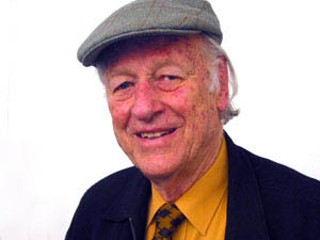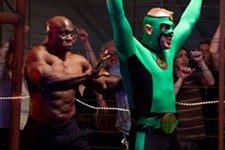Titan, King, God, Monster
An interview with Ray Harryhausen
By Marc Savlov, Fri., March 24, 2006

Gods still walk the earth. I know. I've seen them: towering bronze Talos, striding across a Crete beachhead in pursuit of Jason and his argonauts; the sorrowful Venusian Ymir, its pebbled tail lashing whiplike atop the Coliseum, 20 thousand miles from home, doomed and alone; Mighty Joe Young, hulking, hirsute savior of endangered orphans everywhere; and his great and good forefather, Kong, the King who lived and died on the sword of love only to live again – forever! – in the hearts and minds of the boys and girls who grew up to be the men and women who never forgot his final, fatal plunge into the land beyond beyond.
There are gods and monsters for real, flickering 24 frames per second on the altar of cinema, popcorn terrors that still thrill and still chase candyfloss heroes as stiff as a 2-day-old Twizzler stuck to a Saturday afternoon matinee seat's threadbare bottom.
And then, of course, there's the man who made the gods and monsters, Ray Harryhausen, who, along with pals Ray Bradbury and Famous Monsters of Filmland's Forest J Ackerman, was and is the single greatest architect of silver nitrate dreams Hollywood has ever produced.
Harryhausen's unique status in cinematic history is unrivaled. His perfection of the technique of stop-motion animation, in which small, articulated models are animated frame-by-frame and then optically composited alongside their flesh-and-blood co-stars, has in one form or another influenced everyone from Peter Jackson to Robert Rodriguez, and from Alamo Drafthouse regulars (this writer very much included) to Stephen Spielberg, Joe Dante, Tim Burton, and countless others. Any film fan who can't rattle off at least five Harryhausen films with a grin on his chin is less buff than snuff and is not to be trusted.
Now retired, the 85-year-old Harryhausen makes his home in London, but he'll be stopping in Austin on Tuesday to sign copies of his new book The Art of Ray Harryhausen and host a very special (and very sold-out) once-in-a-lifetime screening of Merian C. Cooper's 1933 King Kong, the film that started him on his fantastic, improbable path of glory.
Austin Chronicle: Tell me about your new book.
Ray Harryhausen: It's a companion piece to last year's Ray Harryhausen: An Animated Life. This one has mainly my preproduction artwork for various films. We don't go into the films per se, but into the preproduction work, and we tried to avoid any copying from the previous book.
AC: Does this include the limited edition, signed and numbered art prints you've been selling?
RH: Those are at the Every Picture Tells a Story gallery in Santa Monica. They're wonderful art-print reproductions of my original drawings that I made for various films, including War of the Worlds, The Seventh Voyage of Sinbad, and so forth ...
AC: I just watched the new DVD of the George Pal War of the Worlds ...
RH: I wanted to do it right after Mighty Joe Young in 1949, but no one was interested at the time.
AC: Do you have a personal favorite among your films?
RH: Well, we always had to make them on a tight budget, and that means you have to compromise a great deal. We tried not to let it show on the screen, but I think Jason and the Argonauts is the most complete. With Clash of the Titans, we had a bigger budget, but most of it went to the stars.
AC: It's a crime when Harry Hamlin [as Perseus] gets top billed over your stop-motion animated Medusa.
RH: We never had big stars in our films, but we never thought we needed them. The actors we did have were very competent, so I think that helped a lot.
AC: What do you think of the current computer graphics revolution in film special effects?
RH: With all the hype that it's been getting, everybody thinks there's nothing better than CGI, but I do get a lot of fan mail saying they prefer our films to anything with CGI in it. I'm grateful for that, and we made them on tight budgets, as I said, so they were considered B-pictures because of that. And, now here we are, and they've outlasted many so-called A-pictures of that period.
AC: Your impact and legacy on both filmmaking special effects and popular culture as a whole is immeasurable. There's simply no one else who even comes close to being the architect of so many fantastically memorable cinematic moments as you are.

RH: Well, I'm grateful that people have seen more into our films than just entertainment, you know? So many people tend to overlook so many things in fantasy. I've read some reviews of Clash of the Titans, and one Midwest moron said Laurence Olivier [as Zeus] looked like a tired old man in a nightgown! And, of course, you knew very well that this critic knew absolutely nothing about Greek mythology. Unfortunately, there are so many incompetent journalists out there. I hate to say that to you, but here in London we had one critic writing in the TV Times that The Treasure of Sierra Madre was spoiled by the music! And, you know, Max Steiner's wonderful score was 50% of the movie's success! Without the music, it would have been just another picture.
AC: Critics! Bah! Anyone who doesn't recognize the lyrical visual poetry of, for example, your skeletons-versus-Jason sequence in Jason and the Argonauts is living in a very sad place indeed ...
RH: I'm so grateful that people see more than just a simple entertainment up there on the screen.
AC: Well, it's one of those movies that people who are truly passionate about film and the artistic possibilities of filmmaking can return to again and again for inspiration.
RH: Wonderful. Today, they make films where you have to sit for an hour and a half and watch somebody in the process of dying and, for me, that's rather depressing. Films, in the good old days of the golden age of Hollywood, used to want to inspire people and give them uplift. You're paying good money to see a film, and you don't want to leave depressed! There's so many subjects today that are on the depressing side, you know?
AC: The world ain't what it used to be.
RH: Yes, but why do we have to emphasize it? Entertainment used to be an escape from the mundane problems of everyday life, you know?
AC: What did you think of Peter Jackson's remake of King Kong?
RH: I was very impressed, of course, but I think they made a mistake in going into the past of the Anne Darrow character [Naomi Watts filling Fay Wray's original shoes]. People who go to see a film called King Kong are not really interested in the characterization and the past of Anne Darrow. I think [Merian C. Cooper's original 1933 King Kong] is so compelling because there wasn't a superfluous word of dialogue or a superfluous cut in the film. Everything led to the main premise of the film. But Peter Jackson's a wonderful filmmaker, and his Lord of the Rings and some of his other films are most impressive. But in his version, it took over an hour to even get to the island!
AC: Tell me about the first time you saw King Kong.
RH: Well, it was such an original thing. I was awestruck when I saw it at Grauman's Chinese Theater in 1933. Nothing like it had ever been on the screen. I had seen [animator Willis O'Brien's 1925 version of] The Lost World when I was four, but that just had simple piano music accompaniment. Max Steiner's score for King Kong boosted the film into another dimension. To me, film music should heighten the image on the screen and make it bigger than life, and that's exactly what Max Steiner's wonderful score did for that film.
AC: By your own admission, you officially retired from filmmaking two decades ago. What would it take to bring you back? Do you ever think about returning?
RH: Not if I can help it! I still go to the conventions, and I like to hear the point of view of people today. I'm a little afraid they're being brainwashed by this new pop-culture. I think it's not really elevating our lives like it did in the good old days of Hollywood, where you had a happy ending. They used to criticize happy endings, but really, what's the point of going to a film if you have to come out hating your fellow man?
AC: Amen to that, and a good question to end on. But is there anything else the legendary Ray Harryhausen would care to add?
RH: Many people are under the delusion that I'm just a special-effects man, but I've worn many different hats in my day. On every film I've been involved in, I worked with the writer and producer. [Producer] Charles Schneer and the writer and myself really formulated those scripts, and some people would criticize them as being too simple, you know, but you can't make complicated characterizations in the fairy tales that we dealt with. We tried to make films that were logical but still had the fantasy feel of it. And eventually I got tired of destroying cities: I destroyed Washington with saucers [in 1956's Earth vs. the Flying Saucers] and New York in The Beast From 20,000 Fathoms [1953]. I enjoy Aardman [Animation's] films with Wallace and Gromit, but they're obvious puppet films, whereas we tried to disguise it and make our effects characters in the films rather than obvious puppets.
AC: The monsters in your films always had as much if not more humanity to them than their human co-stars.
RH: Yes, well, I'm grateful for that. One film critic back in the early days said "It's a pity Mr. Harryhausen didn't animated the actors, too." ![]()
Tuesday, March 28
Alamo Drafthouse South Lamar








